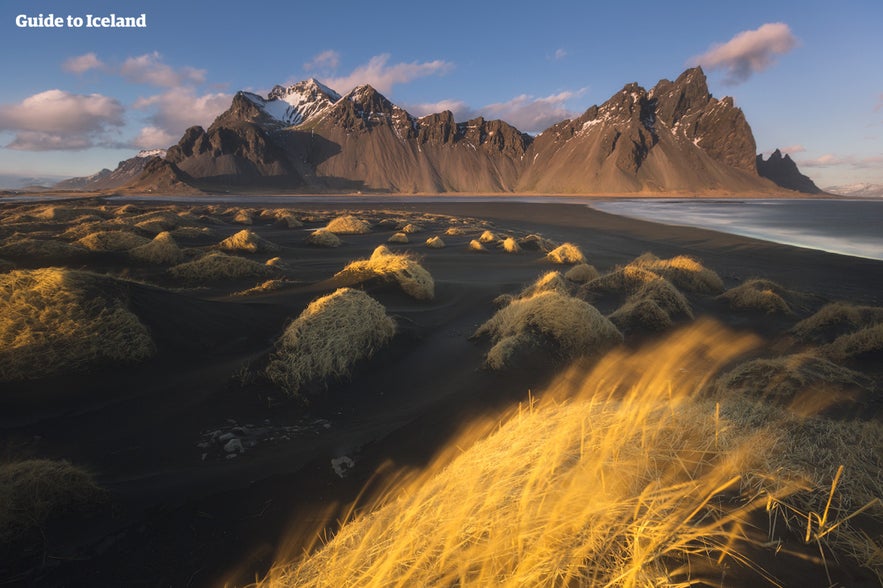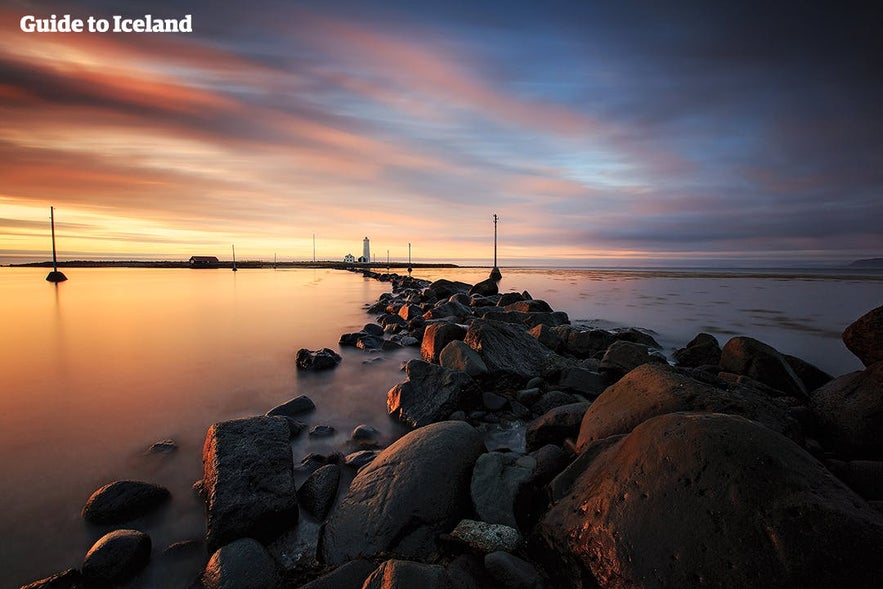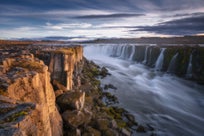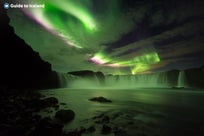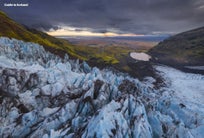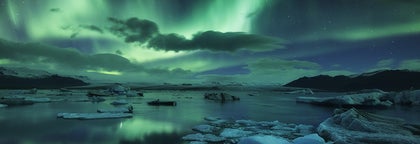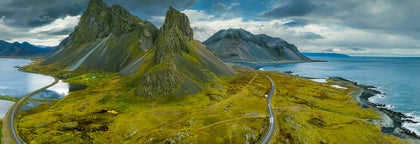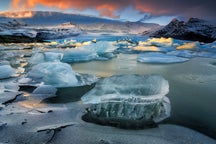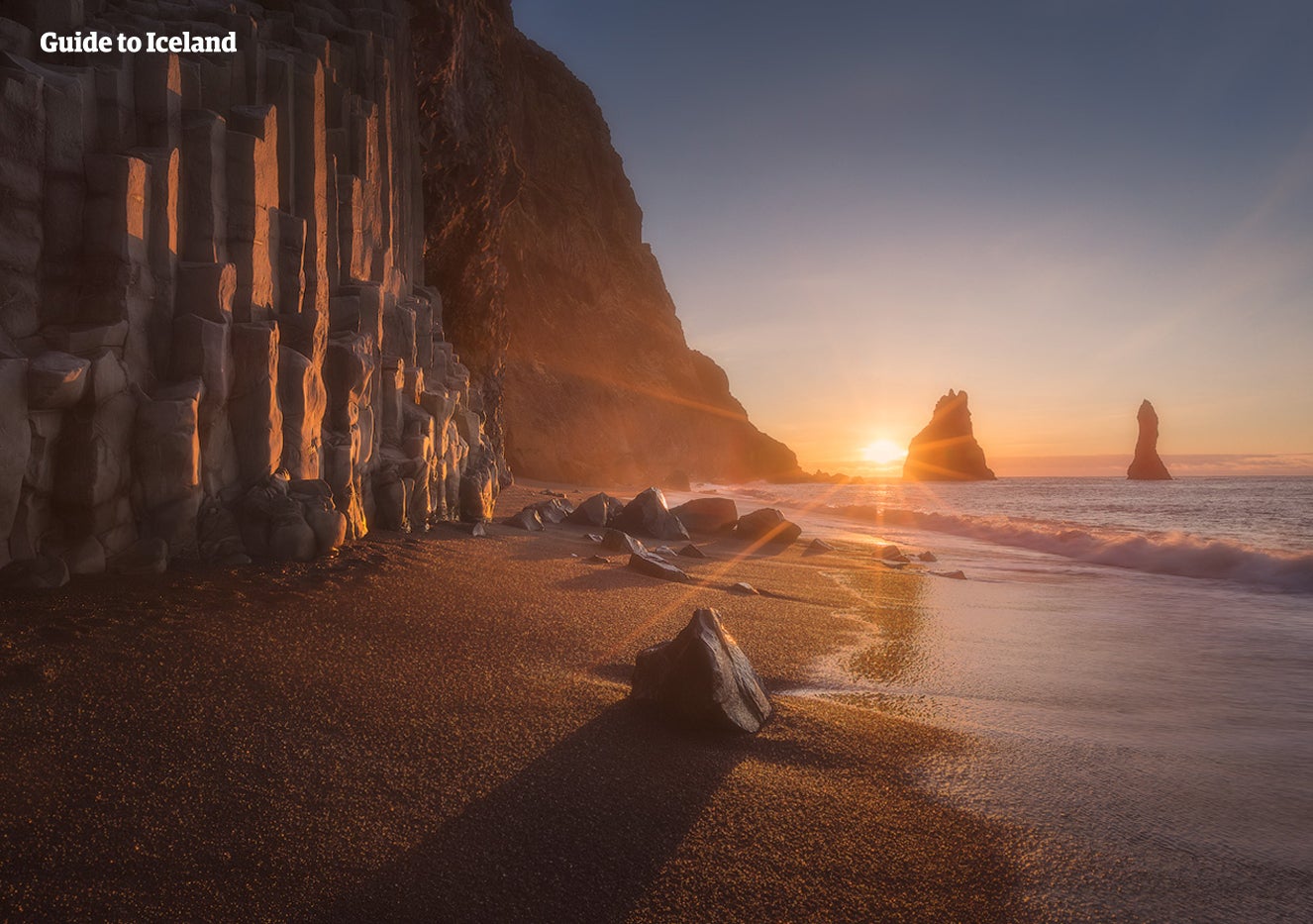
8 Amazing Black Sand Beaches in Iceland

- Why Are the Beaches in Iceland Black?
- What Are Sneaker Waves?
- 8 Amazing Black Sand Beaches in Iceland
- 8. Djupalonssandur
- 7. Eyrarbakki
- 6. Grotta
- 5. Sandvik
- 4. Solheimasandur
- 3. Stokksnes
- 2. Diamond Beach
- 1. Reynisfjara
- Other Beautiful Beaches in Iceland
- Nautholsvik
- Raudasandur
- Breidavik
- Budir
- Ytri-Tunga
- Map of Beaches in Iceland
One of the iconic features of Iceland's landscape is its black sand beaches, where the remnants of volcanic activity meet the steady embrace of the North Atlantic's waves. Experience the raw, untamed beauty of Iceland's rugged coastline as we go over some of our favorite beaches.
As an island at the edge of the Arctic, Iceland exhibits a myriad of enchanting black sand beaches that make up its coastline. When you imagine a trip to the beach, the picture in your head might be of a sunny resort with tropical trees and small huts. The beaches of Iceland, however, are a little different.
The beaches in Iceland are a testament to Iceland's raw and untamed beauty, often flanked by steep cliffs and welcoming the crashing waves against the shore. If you decide to explore the country by renting a car or by going on a self-drive tour, you will find many astonishing locations where the black sands meet the waves. Waking up at a hotel or guesthouse in Iceland with a view of the harsh but beautiful coastline is sure to inspire you to explore everything the country has to offer.
In this article, we'll be going over some of our favorite black sand beaches in Iceland and why they might be a bit different from the ones you're used to. Whether you want to witness the powerful interplay of sea and land in a rugged landscape or go for a tranquil walk along an otherworldly coastline, you should read on to know the best black sand beach locations in Iceland.
- See also: 40 Best Locations in Iceland
- See also: 18 Things to Do and Places to Visit in Iceland
Why Are the Beaches in Iceland Black?
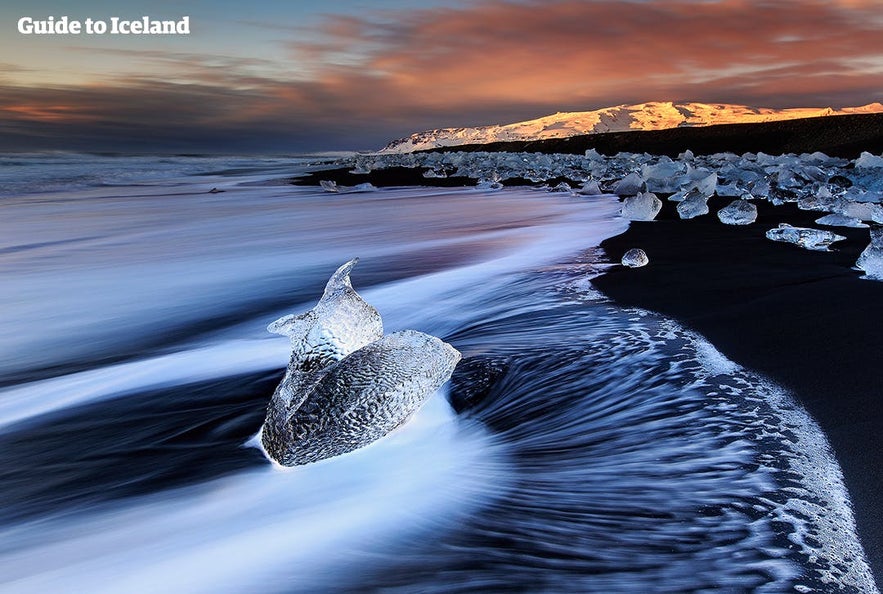
As you'll find out, not all of the country's beaches are black. Beaches of white, yellow, and gold are mostly found on the Snaefellsnes Peninsula and in the Westfjords, with a couple more located in and around the capital area of Reykjavik. In Iceland, these white and golden sand beaches are the exception rather than the norm.
Iceland's active volcanic landscape, sculpted by the country's numerous volcanoes, means that a significant portion of the sand found on its beaches is derived from basalt, resulting in the unique and striking black sand beaches that the country is known for. This feature excites many travelers as the sceneries found at these beaches can feel otherworldly.
What Are Sneaker Waves?
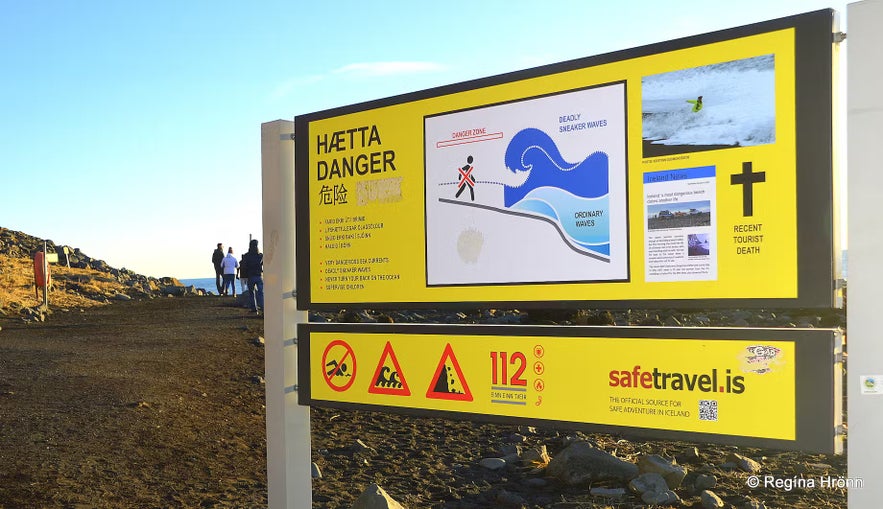 One of the things to keep in mind when visiting many of Iceland's beautiful beaches is sneaker waves - unexpected coastal waves that are significantly larger and stronger than the waves preceding them. These waves can suddenly surge far up the beach with great force, catching beachgoers off-guard and potentially dragging them into the sea.
One of the things to keep in mind when visiting many of Iceland's beautiful beaches is sneaker waves - unexpected coastal waves that are significantly larger and stronger than the waves preceding them. These waves can suddenly surge far up the beach with great force, catching beachgoers off-guard and potentially dragging them into the sea.
Sneaker waves are notoriously difficult to predict as they do not follow a regular pattern, and their occurrence can be separated by long periods of smaller, gentler waves, lulling individuals into a false sense of security. In certain Icelandic beaches, sneaker waves are a common phenomenon, particularly at beaches with open ocean exposure. If you see warning signs alerting visitors to the danger of sneaker waves, maintain a safe distance from the water at all times.
8 Amazing Black Sand Beaches in Iceland
Now, let's go into our picks for the best black sand beaches in Iceland. Be sure to read until the end to hear about some of the country's white sand beaches as well as find a handy map to know where to find these amazing locations.
8. Djupalonssandur
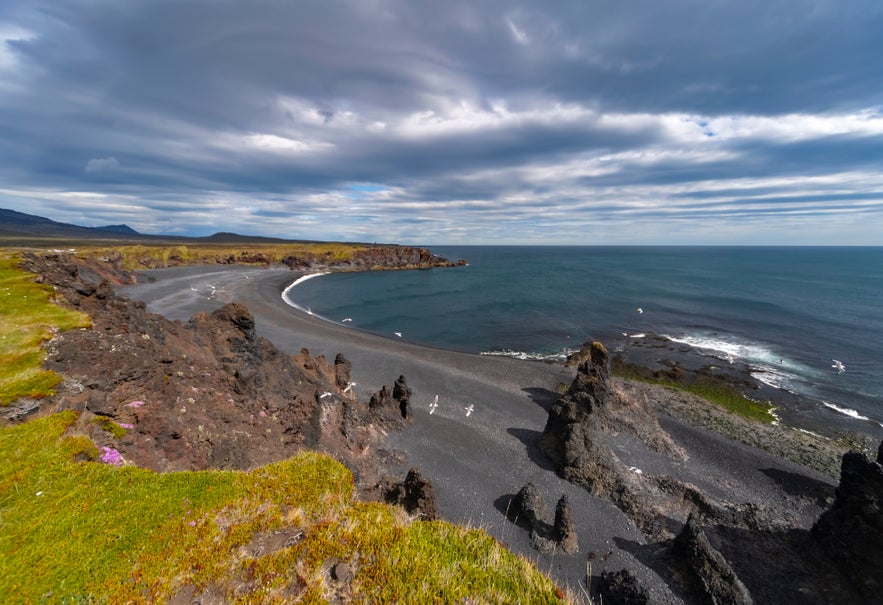
Djupalonssandur, located on the Snaefellsnes peninsula, is a strikingly beautiful location that was once home to a bustling fishing village but is uninhabited today. The coastline has a rich blend of history and natural beauty, with certain odds and ends that give an insight into past residents and practices.
Four ancient lifting stones still occupy the beach, once being to test the strength of the local fishermen. The beach is also home to remnants of the shipwreck of an English trawler that perished in the mid-20th century, offering a powerful reminder of the harsh but beautiful nature of this place.
Behind the cliffs of volcanic rock that surround the beach, you will find two freshwater lagoons, one of which, Djupalon, serves as the namesake of Djupalonssandur. These lagoons are steeped in rich folklore, with various myths having been associated with them throughout the centuries.
- See also: Folklore in Iceland
- See also: The Ultimate Guide to Snaefellsnes Peninsula
A great way to visit this location is on a small group tour of Snaefellsnes, where your guide will give you detailed insight into the fascinating stories and geology of Djupalonssandur beach. Enjoy the scenery and the rich historical heritage to the fullest, but keep in mind that this beach is not for wading, as powerful sneaker waves can catch you off guard.
7. Eyrarbakki
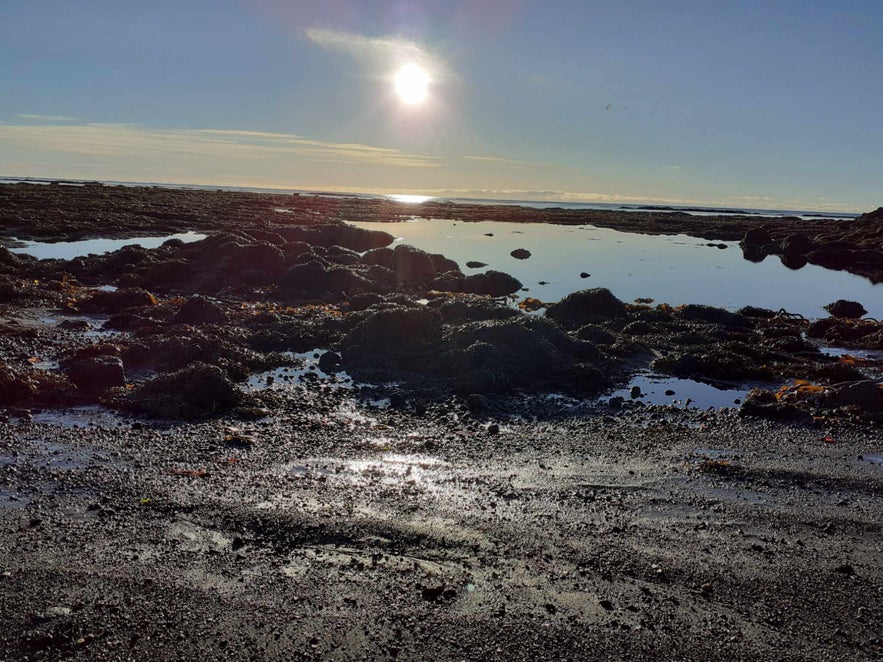
Eyrarbakki is a small village situated along Iceland's southern coast, a quiet and less traversed destination. Visitors won't find the bustling tourist amenities common to other locations, which lends Eyrarbakki a certain untouched charm.
The shoreline of the village is marked more by stones and rocks than fine sand, mirroring the stark yet understated beauty that Iceland naturally harbors. Here, you will find a disused harbor and piers that remain of the village's abandoned fishing heritage. These remnants of maritime culture combined with the ecosystem of the shore and the coarse rock create a beautiful and powerful visual, making Eyrarbakki beach a popular spot for photo opportunities.
As a less visited location, Eyrarbakki is a hidden gem that can be enjoyed without the distracting frills of more commercial tourist destinations. A visit to Eyrarbakki is a brief retreat into the calm rhythms of coastal life, and its location makes for a great Sunday drive on a cheap rental car to explore the village and its surroundings.
6. Grotta
You do not need to venture outside of the capital area to reach a stunning black sand beach. Grotta, located in Seltjarnarnes, is a natural retreat within close proximity to Reykjavik's downtown area. Historically inhabited as early as the 1500s, but nowadays, Grotta's residents mostly include the feathered kind. The beach is off-limits during nesting season every May through June, but at any other time, it functions as the perfect Reykjavík getaway.
- See also: Secret Spots & Hidden Gems in Reykjavík
The most iconic sight at Grotta is its lighthouse which stands as a solitary beacon against the backdrop of the vast North Atlantic Ocean. This lighthouse has overseen the changing tides and shifting seasons, offering a historic touch to the modern developments around it. When the tide is low, visitors can walk up to the lighthouse, which has stood on the beach for over a century. Also found at Grotta is an intriguing wooden structure meant for drying fish and a small hot pool called Kvika in which you can dip your feet after a long day.
Grotta's relative seclusion from city lights, despite being close to the city center, makes it one of the best spots in Reykjavik to see the northern lights during winter. Visiting Grotta is a great addition to any itinerary that involves exploring the city, whether it's for the beach itself or the tranquility.
5. Sandvik
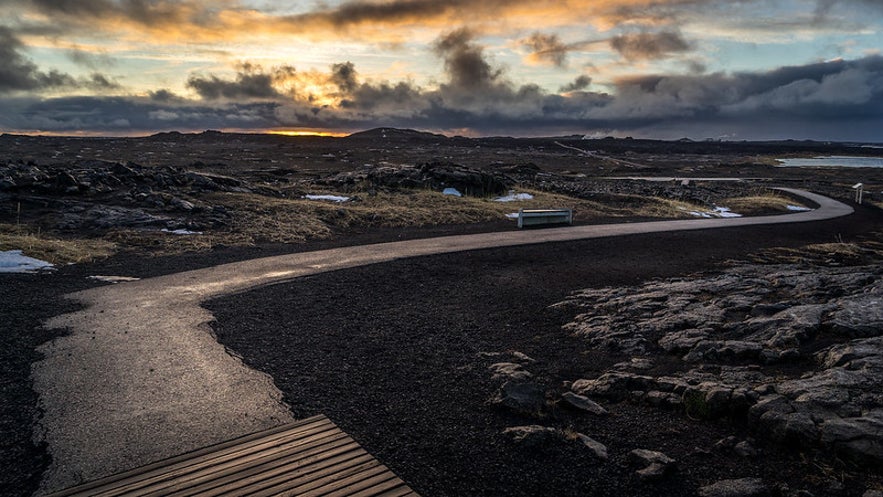 Photo by Giuseppe Milo
Photo by Giuseppe Milo
At the southwest tip of the Reykjanes peninsula lies the black sand beach Sandvik, a sandy and rocky destination that's fun to explore. Sandvik is best known for being home to the Bridge Between Continents, a structure symbolizing Iceland's location atop the Mid-Atlantic Ridge, which separates the North American and Eurasian tectonic plates.
Iceland's unique location on the ridge means that the western part of Iceland is technically in America, while the eastern side is in Europe. The Bridge Between Continents is a great symbol for this, and visitors can enjoy crossing the bridge, thereby crossing between the two continents.
- See also: 22 Best Things to Do in Reykjanes Peninsula
- See also: Best Hotels Near Keflavik Airport
Sandvik is a popular stop when exploring Reykjanes and can be reached within an hour’s drive from Reykjavik. The beach was the shooting location of Clint Eastwood's Flags of Our Fathers, representing the beaches of Iwo Jima. It is also conveniently close to Keflavik International Airport, so a perfect first stop for arrivals who rent a car in Keflavik and wish to explore everything there is to see in Iceland.
4. Solheimasandur
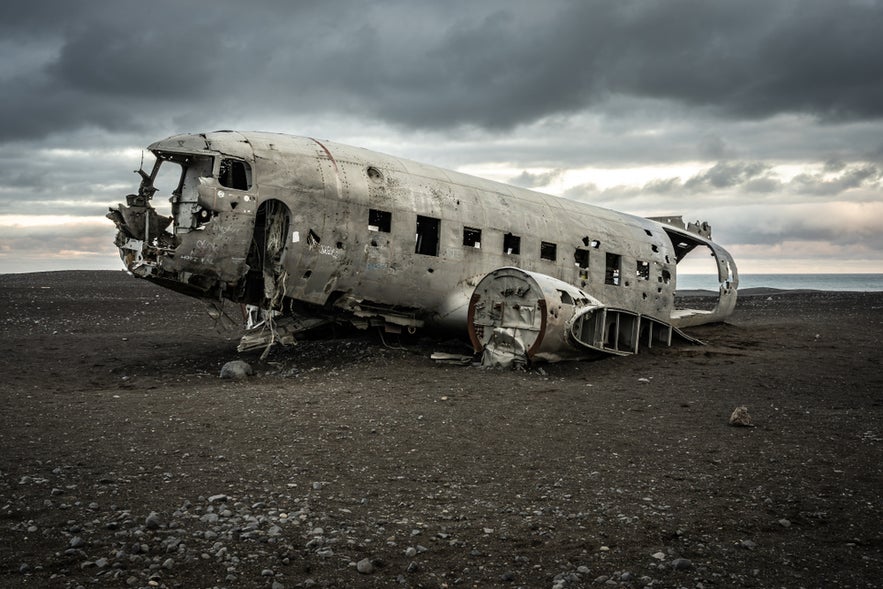
Iceland is composed of landscapes that are in constant development due to the country's volcanic activity. For a striking visual display of the land's volcanic nature, look no further than to the glacial sand plains of Solheimasandur on the South Coast.
This desert of black sand was formed during a massive glacier outburst flood only a few centuries ago, caused by eruptions from the infamous Katla volcano. There’s a reason the whole world is holding its breath for the next eruption of Iceland's most powerful volcano—each time it erupts, the effects it has on the environment are of catastrophic proportions.
- See also: The Abandoned DC Plane on Solheimasandur
The sand is also home to a US Navy DC-3 aircraft that crashed back in 1973. The crew members survived but abandoned their plane, leaving behind an accidental monument of post-apocalyptic allure. The wreckage is a popular photo spot as the aircraft's gnarled metal on the black waste makes for a powerful visual.
A parking lot is found on the road nearest to the wreck, but you should prepare yourself for quite a trek if you decide to walk from there. Alternatively, you could take a comfortable shuttle bus that will take you directly to the wreck from the parking lot or take an adventurous ATV tour of Solheimasandur where you can take in the surroundings while zooming over the black sands.
3. Stokksnes
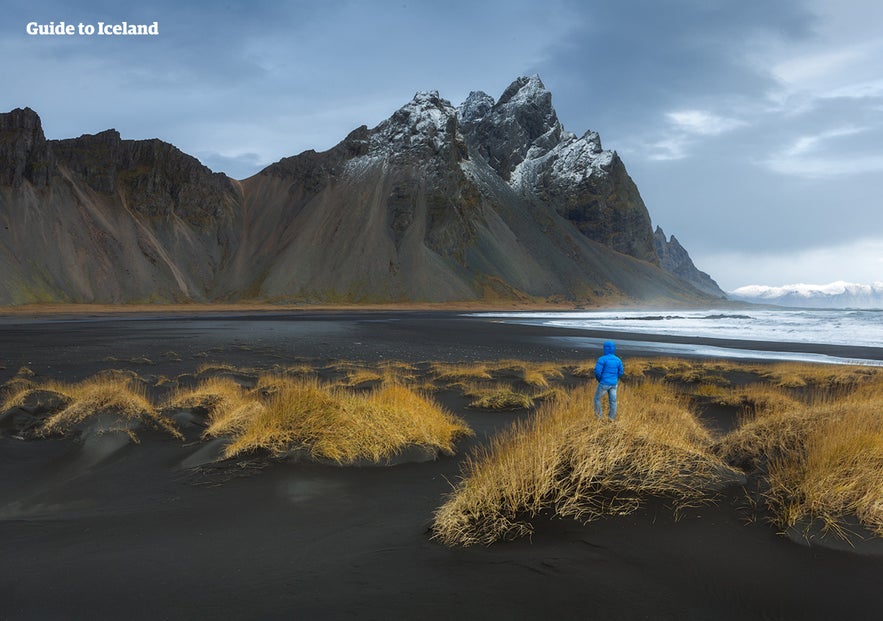
On the headland of Stokksnes in the Eastfjords, there’s a magnificent black beach that stretches out from the foot of the spectacular Mount Vestrahorn. This beach is every photographer’s dream, as natural forces continually shape the landscape yielding different scenic results.
Scouting the beach by Vestrahorn feels like an exhilarating treasure hunt. In the area, you'll find a Viking village made for a film set that got left behind, remains of a NATO radar station, a wooden shipwreck, and a small lighthouse. The site is also historically significant as it counts as one of the more famous locations of Iceland's alleged pre-Viking settlement by Irish monks.
On the shore, there are lava dunes coated with deep-green grass, while the wet sand tends to grant a perfect mirroring of the dramatic mountain that watches over this untouched natural wonder. While admiring all of this, remember to respect the environment; the grass that serves to protect the dunes has sometimes been trampled by incautious visitors.
If you're staying in an accommodation in East Iceland, visiting the beach of Stokksnes and admiring Vestrahorn is one of the best things you can do in the region. If that doesn't sate your hunger for a beautiful beach accompanied by a gorgeous mountain, try driving 40 minutes further east until you find Krossnesfjall, usually referred to as Eystrahorn mountain.
- See also: Sustainable Tourism in Iceland
- See also: The Best Places to Visit in East Iceland
2. Diamond Beach
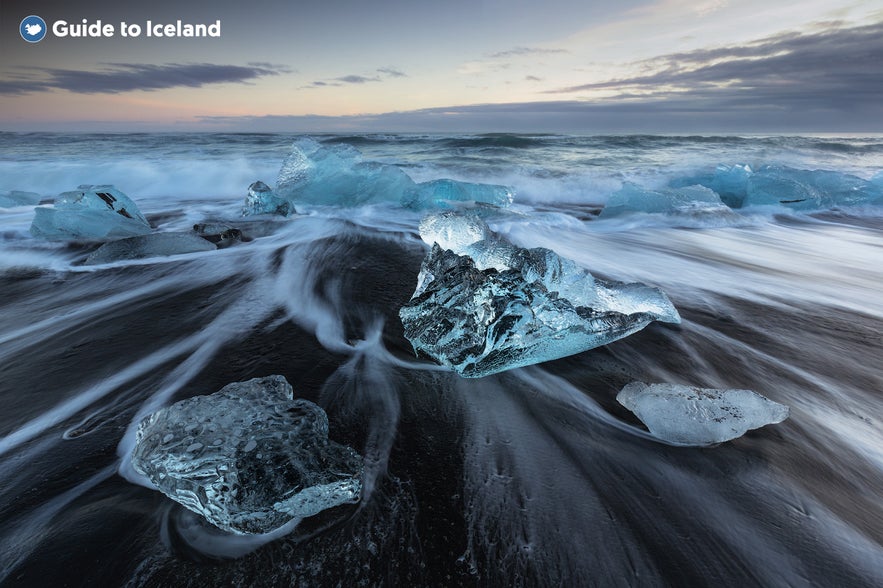
The Jokulsarlon glacier lagoon is one of Iceland's most iconic attractions - a place where you can see towering icebergs float around in a gorgeous lake filled with water from the nearby glacier of Breidamerkurjokull. As the icebergs make their way through the lagoon, or eventually end up drifting to sea or end up on the nearby shore that has become known as the Diamond Beach.
This area, known in Icelandic as Breidamerkursandur, is a glacial outwash plain with vast stretches of black sand. As the icebergs gather on the sands, they glisten beautifully like gemstones, explaining how the nickname of Diamond Beach has stuck.
Located just off the Ring Road, it's easy to see why the beach has become a staple stop for anyone traveling in the area. The contrast of the shimmering icebergs with the black sands beneath them is nothing short of magical and can, at times, look like an image a computer might generate.
Visiting the Glacier Lagoon and the Diamond Beach is an enchanting experience. Many visitors to Iceland are so enthralled with the location that they choose to stay at a hotel by Jokulsarlon to get the most out of their trip. If you want to get a close look at the icebergs, the best way to do so is on a zodiac boat tour of the glacier lagoon, where you'll see the vivid blue color of the ice from a close distance.
1. Reynisfjara
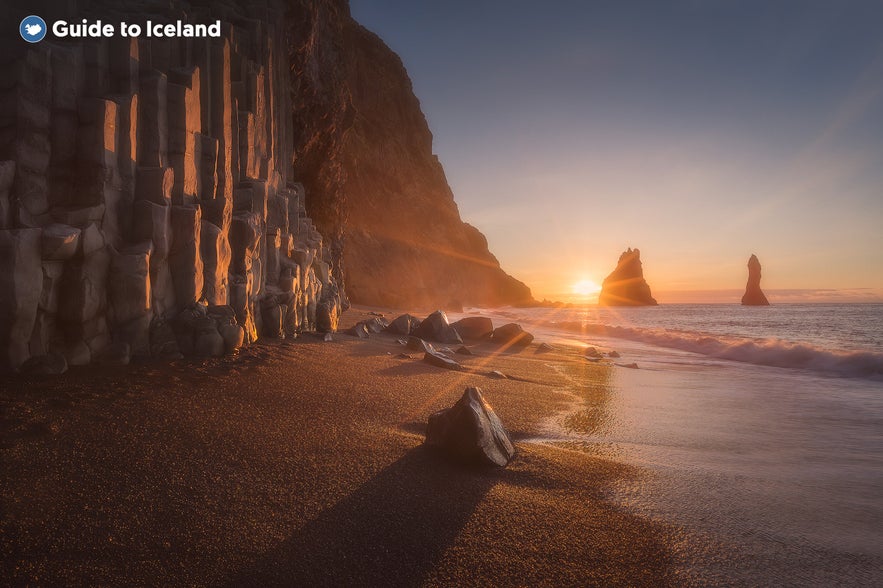
One of Iceland's most famous attractions is Reynisfjara, a black sand beach that rests by the coastal village of Vik. Readily available from the Ring Road, the beach draws flocks of visitors daily, who come to admire the surrounding landscape and the North Atlantic puffins that nest on the cliffs of the mountain overlooking the shore.
Just offshore, the dramatic sea stacks Reynisdrangar rise from the waves. According to legends, these imposing basalt columns were once trolls that tried to pull ships from the ocean to shore. However, as dawn broke, these trolls were turned to stone.
In the vicinity of Reynisfjara black sand beach, you'll find bird cliffs where puffins, fulmars, and guillemots often nest, especially during the summer months. These provide an opportunity for wildlife observation, adding another layer of interest to the already captivating environment.
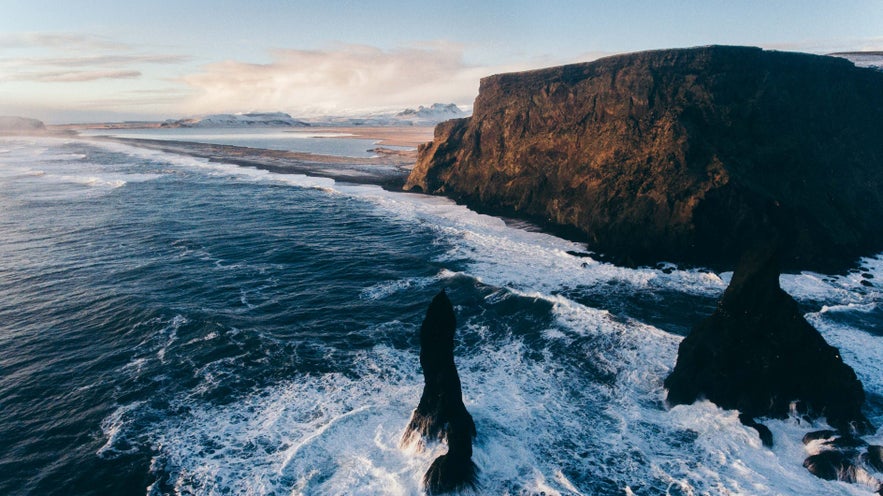 While visually arresting, Reynisfjara is also a beach that commands respect because of its sneaker waves which can strike suddenly and carry visitors who ignore the warning signs away. Visitors are advised to never turn their backs on the waves and keep a safe distance of at least 100 feet (30 meters).
While visually arresting, Reynisfjara is also a beach that commands respect because of its sneaker waves which can strike suddenly and carry visitors who ignore the warning signs away. Visitors are advised to never turn their backs on the waves and keep a safe distance of at least 100 feet (30 meters).
Exploring Reynisfjara beach is practically a must for any visit to Iceland that includes the South Coast. A great way to explore it is on this 10-hour small group tour of the South Coast, where you will also see sights such as the waterfalls of Seljalandsfoss and Skogafoss.
If you want to infuse a bit of adrenaline into your day, consider this South Coast minibus tour with glacier hiking that will take you to explore the scenery at Solheimajokull glacier.
If you are drawn to the beauty of the area, you might want to consider staying at a hotel in Vik. This will grant you easy access to Reynisfjara, and the village will serve nicely as a base of operations for your explorations of the South Coast and its many wonders. There are excellent Vik tours and travel packages available for an exciting trip.
Other Beautiful Beaches in Iceland
While the focus of this article was on the black sand beaches, Iceland's geology is quite varied, and there are plenty of beaches with white or golden sands. We'd be remiss not to mention some of the best ones, so here are some beaches in Iceland that don't have black sand.
Nautholsvik
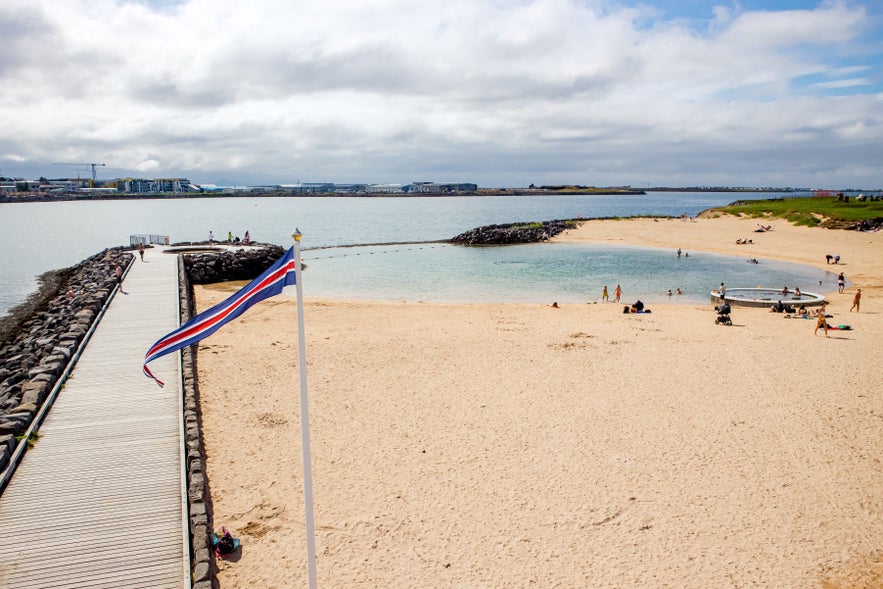
While most beaches in Iceland are carved by nature, Nautholsvik is a man-made beach with fair-colored sand and public facilities. Whenever the weather is nice, locals flock to this location to enjoy some semblance of tropical fun in the North Atlantic.
The beach makes use of geothermal heating to warm the icy waters of the Atlantic Ocean within a barricaded bay, where guests can enjoy the privilege of sunbathing to their heart's content. The beach boasts two outdoor hot tubs, a sauna, dressing rooms, a volleyball net, and the upscale restaurant Strandkaffi, providing all the comforts of an authentic summer holiday.
Nautholsvik beach is conveniently located within Reykjavik, making it an easy place to add to your city plans if the weather allows. One of the city's most iconic landmarks, Perlan, is located nearby, so keep a visit to the beach as an option if you're exploring Reykjavik on the Hop On Hop Off Bus Tour.
Raudasandur
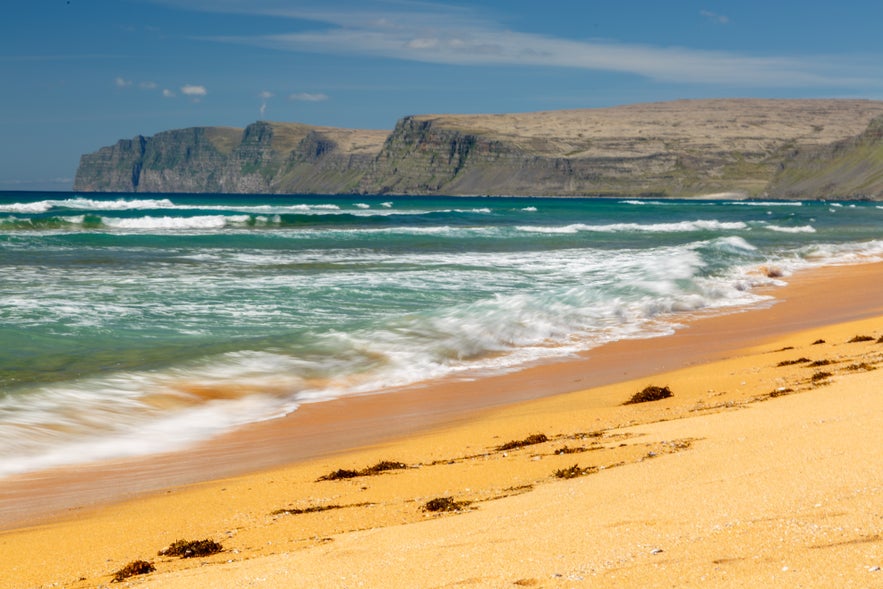
Raudasandur, which literally translates to "red sand," is a beach in the Westfjords that, as the name suggests, has sand with a reddish og golden hue. This unusual coloration is because of the sand's composition, which is made up of pulverized red and pink shells and other marine organisms mixed with the sand.
The beach is seldom crowded, partially due to its isolated location, which requires traversing winding mountain roads to reach it. This lends Raudasandur beach a quiet, almost meditative atmosphere. The beach stretches for about 6 miles (10 kilometers) across the coastline and is home to various species of birds and marine wildlife, making it an ideal location to go for a nice walk.
- See also: Red Sands and a Crime Scene
There are many stories surrounding Raudasandur, one of which has to deal with ghastly murders in the 1800s. To get greater insight into the folklore and myths surrounding the beach and the Westfjords in general, we recommend guidance from a local expert on a scenic 6-hour walking tour to Raudasandur.
Breidavik
Breidavik is another beach located in the Westfjords, en route to one of Europe's largest bird cliffs, Latrabjarg. Steep mountains embrace the beach on each side, while an old farmhouse by the sea provides the most scenic of views.
Visiting the area feels a bit like traveling in Iceland decades ago. A camping site and a river rich in trout offer the perfect getaway for those looking for peace and quiet. Looking over the bay is a small white church donning the quintessential red roof of its Icelandic counterparts.
Although the scenery should be reason enough to make you want to make your way across the unpaved mountain roads to Breidavik beach, most people visit this beach for the puffins. Every year, from April through September, the North Atlantic Puffin returns from the open oceans to breed in its prime location, Latrabjarg Mountain.
Budir
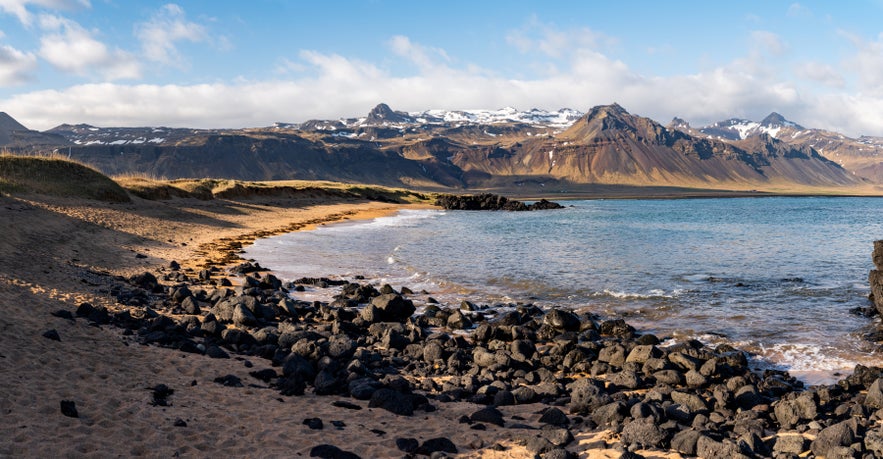 Budir is a popular photography spot in the Snaefellsnes peninsula, mostly thanks to the iconic black church of Budarkirkja. Located a short distance from the church is a gorgeous scenery of tall windswept grass that makes way for a soft blanket of fair-colored sand dotted with jet-black lava rocks.
Budir is a popular photography spot in the Snaefellsnes peninsula, mostly thanks to the iconic black church of Budarkirkja. Located a short distance from the church is a gorgeous scenery of tall windswept grass that makes way for a soft blanket of fair-colored sand dotted with jet-black lava rocks.
Like Djupavogssandur, Budir used to be a vibrant and prominent fishing village and was one of the country's earliest trading posts. But like most settlements in the area, it was abandoned at the beginning of the 19th century.
Nowadays, not much of the village remains except its church and mystical atmosphere. Wildlife enthusiasts will also be pleased to find out that curious seals are often seen lounging in the shallows of the shore.
Ytri-Tunga
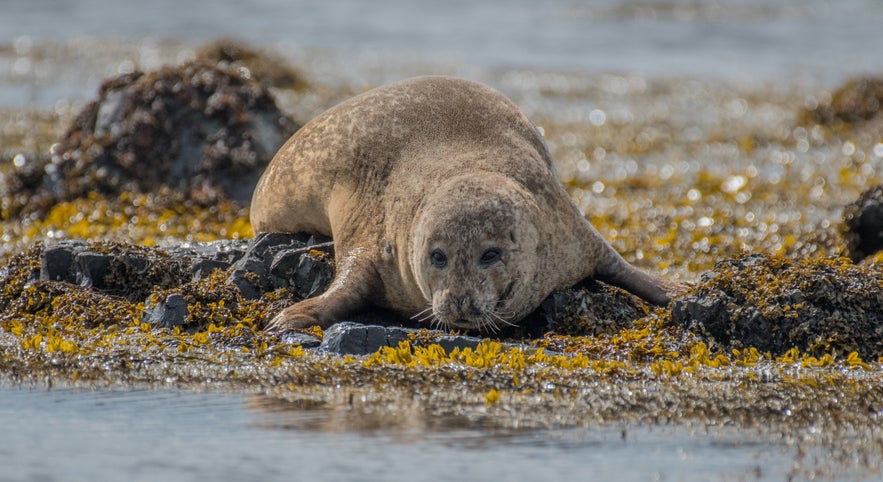 Ytri-Tunga is another beach on the Snaefellsnes Peninsula, with a rocky and pebbled shoreline that's usually covered in seaweed. This quiet area is a popular spot for travelers exploring the region, mostly due to the fact that it is the most reliable spot in all of Iceland to spot seals.
Ytri-Tunga is another beach on the Snaefellsnes Peninsula, with a rocky and pebbled shoreline that's usually covered in seaweed. This quiet area is a popular spot for travelers exploring the region, mostly due to the fact that it is the most reliable spot in all of Iceland to spot seals.
The seal colony at Ytri-Tunga beach is especially prevalent during the summer months. Observing these seals, who seem quite at home along the coast, provides a unique wildlife-watching experience in Iceland.
When visiting Ytri-Tunga, or other beaches where seals are present, movements and quiet voices are essential to avoid causing stress to the seals. Maintain a reasonable distance, especially during the pupping season when mothers are likely to be more defensive. This way, you can observe the fascinating creatures in their natural habitat without being intrusive.
Map of Beaches in Iceland
Did you enjoy our article on the most stunning black sand beaches in Iceland? Are there any that we missed? Let us know your thoughts and feelings in the comments below!
더 많은 흥미로운 게시글
6월의 아이슬란드에 관한 모든 것
아이슬란드를 6월에 방문하기 위해 알아야 할 모든 것을 정리해 보았습니다. 6월의 아이슬란드에서 체험해 볼 만한 액티비티, 각종 문화 행사 및 날씨까지 총망라한 글입니다. 아이슬란드의 6월을 아름답게 빛내주는 백야 현상부터 다양한 볼거리, 즐길 거리까지 알려드리고자 합니다. 여름철에 아이슬란드를 여행하려면 체류 기간 동안 이용할 숙소를 미리 예약해두...더 보기아이슬란드의 새들
아이슬란드에서 가장 흔한 새들은 어떤 것이 있고, 또 아이슬란드의 문화와 어떤 연관을 맺고 있을까요? 아이슬란드의 조류군 많은 여행자들이 아이슬란드의 새들에 관심이 있어 합니다. 주로 사람들은 퍼핀을 보고 싶어(혹은 먹어보고 싶어(?))하지만 아이슬란드에는 퍼핀 말고도 여러 다른 새들이 있답니다. 기록된 바에 의하면 아이슬란드에서는 약 330종의...더 보기10월에 아이슬란드 방문하기|무엇을 하고 어디를 가볼까
아이슬란드의 10월, 이 때 방문할 수 있는 곳들은 어디가 있을까요? 10월의 날씨에 대해 알아야할 점, 어떤 곳들을 둘러보면 좋을지, 짐은 어떻게 싸야 하는지, 10월에 어떤 투어를 즐길 수 있는지, 그리고 어떤 행사들이 준비되어 있는지 알아봅니다. 10월은 아이슬란드에 방문하기에 환상적인 시기입니다. 여름의 성수기는 이미 끝났지만 기온은 아직 한겨...더 보기

아이슬란드 최대의 여행 마켓플레이스를 전화에 다운로드하여 전체 여행을 한 곳에서 관리하세요
전화 카메라로 이 QR 코드를 스캔하고 표시되는 링크를 누르면 아이슬란드 최대의 여행 마켓플레이스를 주머니에 넣을 수 있답니다. 다운로드 링크가 포함된 SMS 또는 이메일을 받으려면 전화번호 또는 이메일 주소를 추가하세요.
